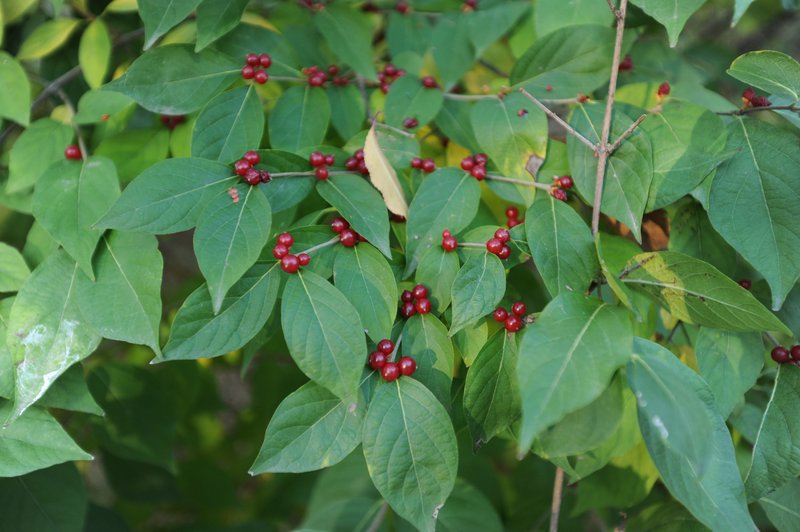FAYETTEVILLE — An alien invader lurks in parks, trails and, possibly, your backyard.
It didn’t come by UFO, but, rather, from bright red berries scattered throughout wooded areas.
Several species of invasive plants, referred to collectively as bush honeysuckles, can rapidly overtake native flora.
The shrubs, thought to have been brought to the United States in the mid- to late 1800s from east Asia, have proliferated in Northwest Arkansas in recent years.
“Fayetteville is the honeysuckle capital of the world as far as I can tell,” Joe Woolbright, owner of Ozark Ecological Restoration, said during a recent survey of the invasive species at Mount Sequoyah Woods.
According to the National Park Service, bush honeysuckles are some of the first spring bloomers and some of the last plants to lose their leaves each fall. They block sunlight to native species, choke off other plants and compete for available moisture in the soil.
At A Glance
Invasive Plants
Bush honeysuckles are one group of several types of invasive species found throughout Northwest Arkansas. Native species, including hollies, viburnum, spicebush, sassafras, trillium, dogwoods, redbuds and serviceberries, can be planted in their place. For more information go to accessfayetteville.org or nps.gov/plants/alien.
Other invasive species include:
• Bradford and Callery pears: Deciduous tree with white, five-petaled flowers
• Chinese and European privet: Semi-evergreen to evergreen bush with dark blue to black berries
• English ivy: Evergreen climbing vine featuring dark green leaves with white veins
• Kudzu: Semi-woody climbing vine with three broad leaflets
• Multiflora rose: Thorny, perennial shrub with clusters of white to pink flowers
• Winter creeper: Perennial vine with dark green, oval, slightly toothed leaves
Source: U.S. National Park Service, Fayetteville Natural Heritage Association, Fayetteville In Bloom And Washington County Extension Service
Honeysuckles can reach heights of 6 feet to 20 feet. They’re characterized by braided, hollow bark; pairs of sweet-smelling, white or yellow trumpet-shaped flowers; and red berries that carry multiple seeds.
For birds and small mammals, the berries are like junk food. They’re high in carbohydrates, but lack fats and proteins migratory birds need for long flights.
Members of the city’s Urban Forestry Advisory Board and Fayetteville Natural Heritage Association are targeting several spots in Mount Sequoyah Woods where honeysuckle is thickest.
Bob Caulk, chairman of the association’s board, said the 97-acre city park was free from most invasive plants 10 years ago. Today, its hiking and biking trails are full of dense thickets of honeysuckle, privet and other invasive species.
The groups have their work cut out for them.
“If you’ve ever pulled honeysuckle, you’ll give up after a day or two,” Woolbright told the urban forestry board last month. “It’s tough.”
Small honeysuckle bushes can be pulled by hand. Medium-sized shrubs can be dug out of the ground using a weed wrench or dibble bar. Larger plants require a chain saw.
Megan Dale, the city’s urban forester, recommended cutting honeysuckle as close to the ground as possible. She said stumps should be treated immediately with a glyphosate herbicide, such as Roundup.
Constant vigilance is needed.
“Honeysuckles that are cut once and left to grow will often form stands that are more dense and productive than they were prior to cutting,” according to the National Park Service.
Woolbright recommended multiple treatments over the course of several years. He said prescribed burns can be the most cost-effective method for eliminating honeysuckle in heavily infested areas.
Pete Heinzelmann, a member of the association, urged Parks and Recreation staff members and individual homeowners to make honeysuckle removal more of a priority.
“We can’t eradicate this stuff all at once, but I think Fayetteville needs to establish a plan and method for doing it,” Heinzelmann said. “It’s a major problem.”
Dale said the Parks Department doesn’t have a budget for removing honeysuckle, but could consider setting aside money next year.
“We haven’t had the resources to attack it,” said Alison Jumper, parks planning superintendent. “We do work with various volunteer groups to help us remove it on parkland.”

